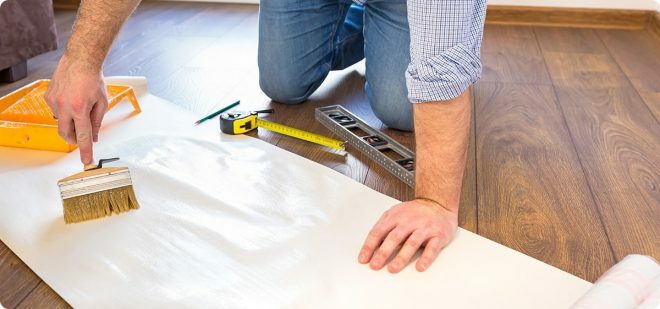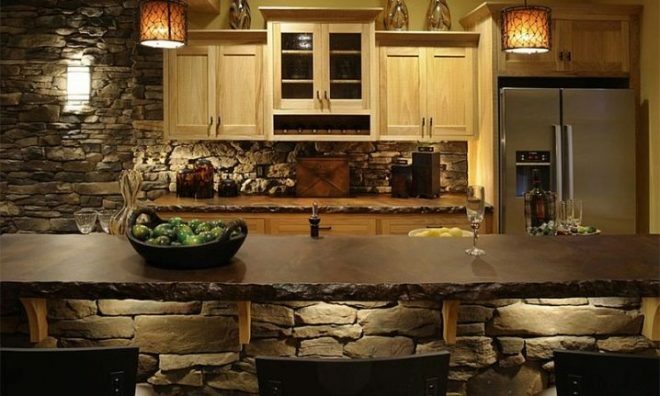 It takes ~ 3 minutes to read
It takes ~ 3 minutes to readThe wall adjacent to the kitchen table has to be washed daily. Neither plasternor wallpaper water with detergents will not withstand. Need protection against steam and abrasives, not absorbing grease protection - the so-called apron. But at what height should it be from the kitchen floor? In this article, we will consider standard sizes and from which material to choose it.

Types of materials
Existing materials with the necessary properties are divided into the following categories:
- Synthetic
- PVC lining;
- PVC panels
- Laminated MDF panels;
- Postforming;
- Acrylic mosaic;

- Natural
- Wooden lining;
- Sawn stone sandstone;

- Sheet glass (chained)
- glazed ceramics (including majolica);
- glass mosaic.

Traditionally, preference is given to tiles (more details), but there are difficulties when laying. It is preferable to mount wood, plastic, sheet glass using an installed countertop - as a support and a guide plane. Ceramic protection is placed in the absence of wall furniture, with an overlap of 5-10 cm for future cabinets, as well as upper cabinets. This approach is explained by the fragility of tile adhesives and ceramics. The ends of the table and hanging cabinets in a collision can chip the edge of the tile. Closer to the center, the glued tiles are stronger.
The situation is aggravated when the kitchen table is tiled with apron with a special set, in which there are ceramic skirting boards. They make friezes with friezes, “pencils”. In this case, “extramural” masonry is not suitable, tables and cabinets must be purchased in advance.
Criterias of choice
The ideal material for the kitchen apron has not yet been invented. Some materials are too expensive, others are difficult to process, while others are mounted for a long time. If you give a rating of 5 stars on the above parameters, the following is obtained:
Material |
Durability |
Installation |
Price |
Decorative properties |
Ceramics |
***** |
* |
*** |
**** |
Tree |
**** |
***** |
** |
** |
Skinali |
*** |
** |
* |
***** |
PVC panels - print |
* |
***** |
***** |
**** |
PVC cellular panels |
** |
***** |
***** |
** |
Glass mosaic |
***** |
*** |
* |
***** |
Acrylic mosaic |
**** |
**** |
* |
***** |
MDF postforming |
**** |
***** |
*** |
* |
The more seams, the harder the care. But if "beauty requires" - mosaic, cross cuts of wood, lining under epoxy varnish, pebbles under glass and in the thickness of the plaster are acceptable. The choice is made according to the general design plan, based on time, money.
Standard apron height size
It is customary to paste over tiles “from wall to wall” and to the front horizon of the countertop (U-shaped configuration). If the table is limited by a refrigerator, a high chest of drawers - the ceramic layer may partially go behind them.
The selected module of furniture sections is taken into account. Sections with sizes that are multiples of 10, 12, 15, 30 cm are produced. Manufacturers of ceramics do exactly the same, tiles of such sizes are popular.
Let's say the height of the pedestals is standard. Together with the legs, drawers, countertops, the total height is h = 0.850 m (high housewives can set a height that is more convenient for them). Then the first row of tiles with a size of 12 x 12 cm is laid at a level from the floor: 850 - 100 = 750 mm. The tile will go ten cm down behind the countertop, 2 cm will peek out. At the junction of the table and the apron, it is necessary to lay the protective baseboard, it will cover the protruding 2 cm.
The following rows are laid from the level of 870 mm (from the top edge of the tile projecting above the table) to the level of 1,596 m, laying out in this way 5 rows of tiles with 1-mm seams between them, the 6th - the one that goes behind the hanging locker. We get a distance of 0.626 m closed with an apron with allowances up and down. As you can see, the height is close to optimal.

Is there a standard: width calculation
After laying the front of the wall, the working surface became narrower. Due to what happened? Tile with a thickness of 5 mm + 10 mm glue.
Suppose a countertop is made of postforming with a standard width of 0.6 m. A multiple of 120 mm is the size used. But minus the seams, minus 15 mm taken by the front, we get:
(600 - (1 mm (fillet seam) + 15 mm + 4 mm (on the 4 seam wall)): 4 = 576 mm
This number will have to operate. Part of this value will take 480 mm - covered with four full tiles. How to cover the remaining 96 mm so that the apron is flush with the edges of the table?
Two ways: cutting tiles with edging by a PVC tile end face or using the manufacturer's friezes. Strips of 2 cm, 3 cm or more are intermixed with the general formation. They can be transverse, longitudinal.
When the issues have been resolved with the vertical and horizontal lines, you can prepare for the purchase by calculating the total area of the material: S = 7 rows of tiles x 0.12 x 0.12 x L =... m2. Let's say the wall is 3 m long. At such a distance, 3000/121 mm will fit 24.79 squares - 25 full. Then the desired number with a table top of 60 cm is 7 x 0.12 x 0.12 * 25 = 2.52 m2. At the ends (on both sides) 2 x 0.12 x 0.12 * 6 = 1, 201 m2. As you can see, the area of the tile purchased is different from the area under the apron plus.
From end cuts, the masonry is saved by a "ladder", with teeth. But this approach is acceptable for the Gothic style - a plinth peeping from the wall is read. For such a masonry, an elongated facing boar tile is suitable. Most often issued not glazed.
Installing the apron under the hood
A continuous stream of heated air, droplets of fat turning into drying oil - a huge load for any finishing material.

It is clear that PVC plates with prints and a protective layer applied on them (a few microns of an acetate film) can last only a short time. It is necessary to wash such a print after each cooking.
Polished porcelain tiles are recommended. The new material has all the necessary qualities, including the ability to polish on the edges after cuts. Stacked in a diagonal way - highly decorative. Laying in stripes, checkerboard pattern is possible. In the latter case, alternating with 2 x 2 cm majolica inserts looks good. They beat off such a strip with ceramic borders. Porcelain stoneware is thought up for floors, therefore its specific gravity (due to density) is higher than ordinary ceramics. Laying porcelain tiles follows from the floor itself or from the level of the slab, but reinforcing the bottom edge with a duralumin-aluminum profile.
A gap from the hob is necessary. It is accepted that fat scatters 15 cm. So, the width of the strip hood-stove is 90 cm. Favorable width for large hoods.
For mini hoods with an inclined catching surface, an additional restriction is needed for a couple - a visor from a laminate is hung above the cabinets from the ceiling.
In an apartment with tall people - 185 cm and above - a hood is attached at the same height (on the lower edge). We calculate the area of the “hood-cooker” strip: 185 - 85 (table and stove level) = 100 cm. Result: 0.9 m2 without pads up and down. But since the linings are necessary and are at least 5 cm - the final desired: 0.05 x 0.9 x 2 + 0.9 = 0.99 m2.
At what height from the kitchen floor do you install
The tabletop level standard is 850 mm. In furniture stores, lower drawers are displayed more often without lower legs, seem lower. With non-standard sizes of pedestals (performed manually or on order), the table horizon is determined, which is drawn on the wall under the level.

Often, pieces of furniture roll up under the countertop, mounted on 2 extreme stands. Then tiles pave the entire wall. A possible option - behind the tables there are cheap materials, above - expensive, decorative.
When laying ceramics on the floor and wall at the same time, it is necessary to take into account the thickness of the flooring - usually 25 mm. 850 + 25 = 875 mm - the boundary line for the countertop.
Masonry below the table is desirable. It’s okay if there is a gap above. Such a gap is laid by the baseboard. But the skirting board can break the rapport (tile pattern). Skirting board (usually made of aluminum) is measured, added to 850. Let's say the skirting height is 2 cm. Then the seam of the bottom row of tiles should pass at a level of 870 mm from the finishing floor.
What to do with outlets?
Issues of electric power supply cannot be put to a number of finishing works. Above the line, broken off by an angle of 850 (or another size - the horizon of the countertop), they plan the placement and number of outlets, given that the decorative rim has its own width. For most outlets, the rim is 2-centimeter. Euro jacks have a standard diameter of 4 cm. This means that each nest (or group of nests) should be 4 cm, and when a baseboard is provided 4 + 2 cm = 6 cm. We will ditch over the unpaved floor according to the calculation: 25 mm (floor) + 850 mm (stand and table top) + 60 mm (body of the socket, its edging, baseboard) = 925 mm.

Sockets of sockets should fall into the crosshair of the tile seams. Cutouts cannot be made inside the tile. In the case of skinheads, sockets are made within open shelves adjacent to the apron walls, even in the bottoms and sides of cabinets.
Video: installing a kitchen apron
With great interest I always read your comments to my articles. If you have any questions, feel free to ask them, leave, you are welcome, Your feedback in the form below. Your opinion is very important to me. Thanks to your criticism and thanks, I can make this blog more useful and interesting.
I would be very grateful if you rate this post and share it with your friends. This is easy to do by clicking on the social media buttons above. Do not forget the article you like Add to bookmarks and subscribe to new blog posts on social networks.


